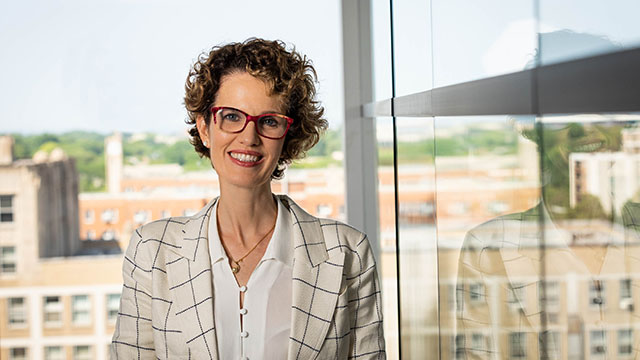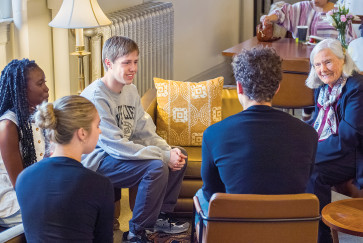Annelise Riles is executive director of the Buffett Institute for Global Affairs at Northwestern and associate provost for global affairs. She is also a professor of law and anthropology.
In this Q&A, she explains that universities like Northwestern are in prime position to lead in times of global crisis because they nurture collaborative solutions and garner broad, widespread public trust.
What role can universities play in addressing global challenges like the COVID-19 pandemic?
Universities can make a huge difference in a crisis like this. We are already seeing it in our research collaborations that spark and nurture creative research solutions. I have seen so many cases of ingenuity and incredible innovation bubbling up from different corners of our University through the Idea Dialogues we’ve recently held at the Buffett Institute for Global Affairs.
One recent dialogue led by Matthew Grayson, Northwestern Engineering Global Initiatives Director and Buffett Global CouncilMember, resulted in Northwestern researchers in biomedical engineering, materials science, microbiology, immunology and pathology working together to chart a course toward producing a low-cost, rapidly scalable swab design for COVID-19 testing.
So, in some ways, a global pandemic like this is an opportunity for universities to lead?
Yes, exactly. Universities are one of the institutions in society that still garner broad, widespread public trust globally. Given that, we have a special role to play as conveners of thought leadership from all sectors, all political points of view and all corners of the globe. The best solutions to global challenges are collaboratively produced.
Universities are also trainers of global leaders. As we think about not just current crises, but crises to come, we need to prepare the next generation of leaders to understand problems from a global perspective—to be able to work effectively with people who do not share their background, history, culture, language or political points of view. We need to equip them with knowledge of the world and its history and its diversity so they can be best leaders they can be.
How is this different from the role universities have played in the past?
Since the Middle Ages we’ve had a concept of the university as a campus — a place in space where people come to learn disciplines, and those disciplines are often divided literally by walls. Students and faculty in different disciplines might be studying the very same phenomena in different parts of the same building and wouldn’t put those pieces together because they’re working from two different points of view.
Nowadays, we’re coming to understand that we have to approach problems from a problem-focused place as well as a discipline-focused place. It’s no longer just about learning bodies of knowledge; it’s also about thinking creatively across those bodies of knowledge to address problems. Many of the real innovations today are coming out of the crossing of traditional bodies of knowledge — where different bodies of knowledge intersect.
And while the physical campus will remain important, it will need to be deeply supplemented with connectivity and networks that stretch across space.
Can you share an example of how universities, including Northwestern, have broken out of their “ivory towers?”
I think of the innovations happening at Medill and Northwestern’s Knight Lab in terms of meshing new technologies with knowledge of the performing arts, design and software development to push journalism and storytelling into new spaces, David Figlio’s work at the intersection of health and education, historian Ken Adler’s work on the relationship between technology and politics around the world, and Kathleen Bickford Berzock’s groundbreaking exhibition that provided a view on the Middle Ages through the lens of western Africa.
In the context of the current COVID-19 pandemic, I think about the work Kris Hammond and his team have done in partnership with the public and private sectors to launch the Emergency Response Exchange to address urgent COVID-19 medical supply needs and the asynchronous virtual roundtable discussions Northwestern Transportation Center Director Hani Mahmassani is organizing.
Why is this difficult for universities? What can stand in the way of this kind of approach?
Speaking now as a faculty member and as a scholar, we scholars for the most part are trained to be racehorses in our own lanes — to be the very best performers and push the frontiers of knowledge in what is often a quite narrow field of inquiry. However, because of that, we sometimes feel uncomfortable when we step into another space. It can feel awkward, risky and sometimes frustrating, because we don’t entirely understand the terms of the conversation among people in other disciplines or from other parts of the world. That can seem to take a lot of time and seem inefficient compared to running the race we run so effectively, but that’s what we’re called upon to do now.
We have to continue in our own lanes to be the very best we can be, but we also have to take the time to look sideways — to take risks and make connections and follow some pathways that are not so well defined for us, and where payoffs are not so clear. It’s mission critical for universities to build in space for undirected improvisation and experimentation. Oftentimes, that will lead to a dead-end but, every once in a while, it will produce the next great discovery.
What’s next for Northwestern, and what most excites you about this?
We’re reorganizing ourselves in a way that promotes connectivity across fields and national boundaries. We’ve created a structure at Northwestern Buffett through which ideas can emerge from the ground up and then get filtered by a cross-disciplinary group of experts. That’s a very different model from some of our peer institutions in which an individual — a director of an institute, for example — chooses what he or she thinks are the most important ideas. We take the exact opposite approach, and I think it’s the right approach.
This kind of collaboration is building new communities on our campuses. Faculty who were never connected or who weren’t necessarily interested in each other’s perspectives before are suddenly connected and excited about each other’s work. That has tremendous value in the way that it creates a rich, thick tapestry for our research and intellectual leadership, within and outside of a traditional disciplinary structure.


